Selecting the right aggregate for your resin-bound gravel surface boils down to four key factors: type, size, colour and texture. Natural stone or recycled materials work best, with sizes ranging from 1-10mm ensuring proper bonding. Think about colour carefully – soft beiges and greys suit most gardens, whilst deeper tones create striking features. Much like choosing paving, the texture should match your needs – smoother finishes work well for driveways, whilst coarser grades offer better grip for paths and steps. Quality matters too – premium aggregates might cost more initially but need less maintenance over time. For best results, chat with local suppliers who understand British weather conditions and can recommend tried-and-tested options.
Key Takeaways
Choosing Resin-Bound Gravel Aggregates
For driveways, opt for angular stones – they lock together brilliantly and won’t shift under car wheels. Round stones are spot-on for garden paths and decorative areas, offering a smoother finish.
Match your aggregate size to the resin depth – you’ll want the resin layer three times thicker than your largest stone for proper binding. A 3mm stone needs roughly 9mm of resin for lasting results.
Colour-wise, think about what suits your property. Neutral greys and browns never go out of style and work with most house types. Fancy something modern? Bold blacks or warming terracottas can create striking features.
Always go for washed, kiln-dried stones. They’re worth the extra cost – dirty or damp aggregates can weaken the bond and cause headaches later with maintenance.
Got specific questions? Have a chat with local resin specialists. They’ll know which aggregates work best in your area and can match your vision to the right materials.
Understanding Aggregate Types and Sizes
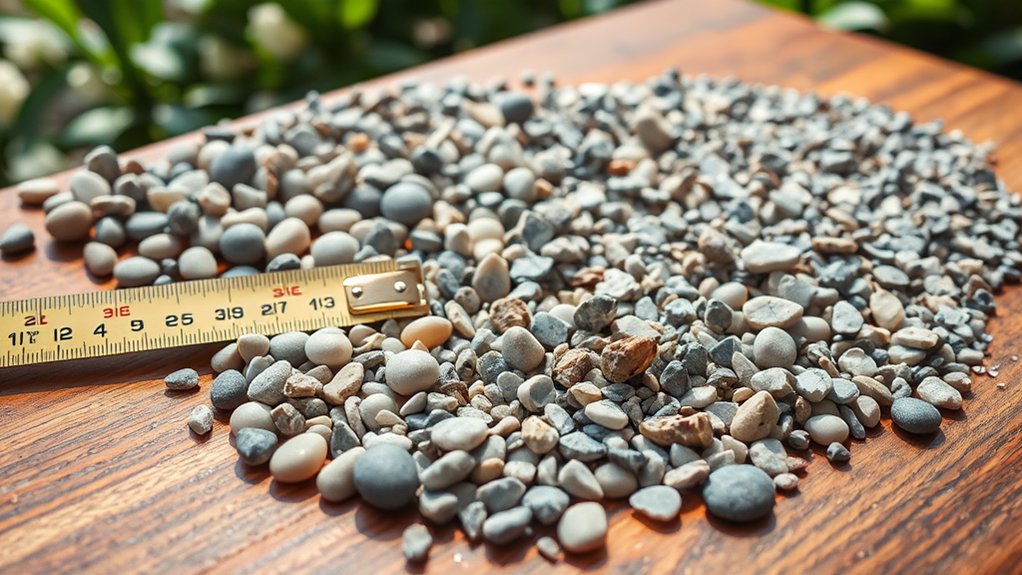
Choosing the right aggregate for resin-bound gravel is crucial for both looks and performance. You’ll find three main types: natural, manufactured and recycled. Each brings different benefits to your project. Angular stones offer better strength, making them ideal for driveways and high-traffic areas. Round stones help with drainage and work brilliantly for garden paths and decorative features. Additionally, using washed & kiln-dried aggregates ensures optimal performance and longevity for your resin-bound surface. When selecting aggregates, consider that DALTEX Aggregates provides UV-stable solutions which prevent yellowing over time.
Size matters – aggregates typically range from 1-10mm. A good rule of thumb: your resin layer should be three times thicker than your largest stone to ensure proper binding and durability. Before starting, consider where you’ll use the surface. A busy driveway needs different aggregate than a garden path. Getting these basics right will save you headaches later and ensure your resin-bound surface performs well for years to come.
Exploring Color Options and Aesthetic Appeal
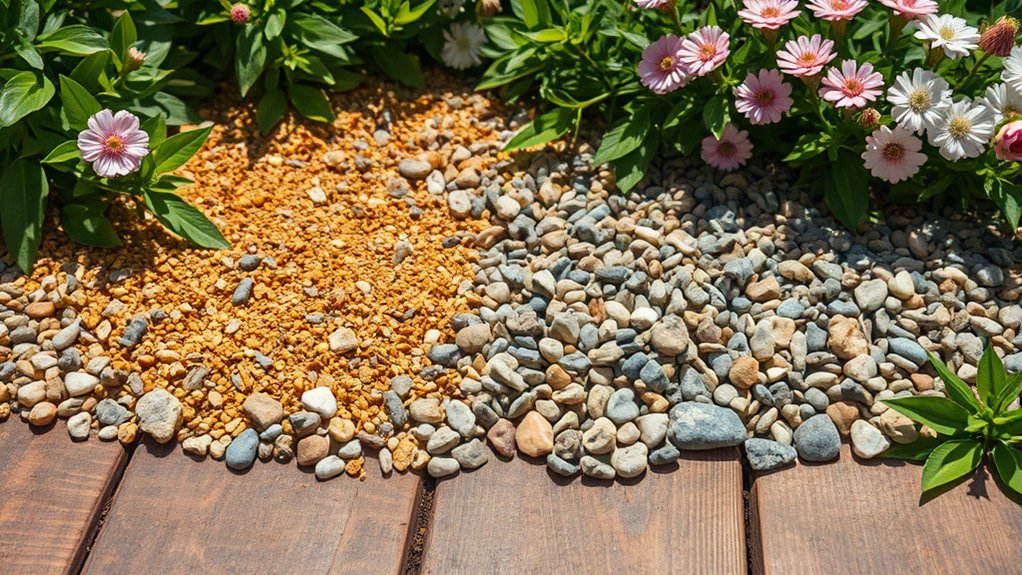
Choosing the right colours can transform your outdoor space from ordinary to extraordinary. Colour choice affects the overall feel of your garden or driveway, so it’s worth getting it right. Neutral shades like white and beige create a clean, timeless look, whilst black offers bold, striking accents that work brilliantly for modern designs. Natural tones, such as Pevensey’s warm golden finish, blend beautifully with garden settings. For a touch of elegance, Silver Cloud’s metallic finish catches the light brilliantly, whilst Pink Opal adds subtle warmth. When picking your aggregate, think about how it works with your house’s exterior and garden features – a matching or contrasting colour can make all the difference. Additionally, the DALTEX collection features 48 unique gravel blends for limitless designs, providing you with a wide range of options to suit your style. Be sure to consider the impact of frost-resistant aggregates on patio longevity, especially in the UK climate. Keep your colour scheme consistent throughout to create a polished, professional finish. Whether you’re updating a Victorian terrace in London or a modern build in Manchester, your choice should reflect both your taste and your property’s character.
Assessing Durability and Maintenance Requirements
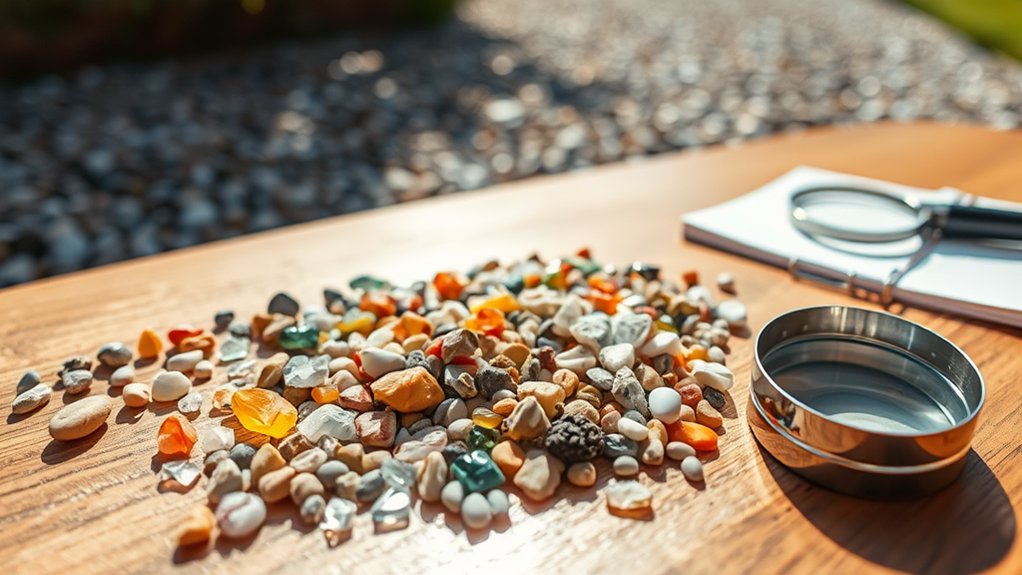
Assessing the durability and upkeep of resin-bound gravel boils down to three key factors: quality materials, proper installation and regular maintenance.
Top-grade aggregates and UV-stable resins typically last 15-20 years with minimal care. Much like caring for a garden path, basic maintenance involves sweeping away debris and occasional power washing to keep the surface looking fresh. Ensuring that the aggregates are clean and dry before installation is crucial for optimal bonding and longevity, and the chemical bonds formed during curing significantly enhance surface strength.
The surface handles British weather well, though it’s worth checking that your installer offers a solid weather-resistance guarantee – most reputable firms provide 10-year warranties.
Getting these basics right means you’ll have a hardwearing surface that needs little fuss.
Surface Longevity Factors
Surface Longevity Factors for Resin-Bound Gravel
Getting the most from your resin-bound gravel surface boils down to several key factors:
- Material Durability: Choose tough aggregates that won’t break down under everyday use, much like selecting granite over sandstone for your kitchen worktop.
- Resin Quality: Invest in top-grade resins that won’t yellow or weaken in British weather. Think of it as buying a proper waterproof coat rather than a cheap plastic mac.
- Installation Standards: Proper fitting is crucial – a skilled installer will ensure the right base preparation and mixing, similar to how a good builder wouldn’t lay a patio without proper foundations.
Weather and usage play major roles too. A driveway in rainy Manchester needs different consideration from a garden path in sunny Cornwall.
Heavy vehicle traffic will naturally affect longevity more than occasional foot traffic.
Sort these basics, and you’ll end up with a surface that lasts years without hassle.
Maintenance Practices Overview
Regular maintenance is vital for keeping resin-bound gravel surfaces in top condition.
Sweep regularly to clear leaves and debris that might block drainage.
Give surfaces a light pressure wash with warm water once or twice yearly – think of it like giving your driveway a proper bath.
Remove fallen leaves and other plant matter straight away to stop weeds taking root and water backing up.
If you spot moss or the odd weed, use gentle, pet-friendly treatments rather than harsh chemicals that could damage the surface.
Keep an eye out for any drainage problems or damage during your routine checks.
Worth noting: a professional clean and reseal every few years will help protect your investment, much like servicing your car.
Weather Resistance Assessment
Weather Resistance for Resin-Bound Gravel
Testing weather resistance of resin-bound gravel surfaces proves crucial for British weather conditions. The assessment focuses on three key factors:
1. Durability: The aggregate must cope with typical UK weather swings – from summer heat to winter frost – without cracking or crumbling.
Think of how garden paving often cracks after harsh winters; proper testing prevents such issues.
2. Porosity: Well-chosen aggregates should handle British rainfall effectively.
Good drainage stops puddles forming and prevents damage from freeze-thaw cycles common in UK winters.
3. UV Stability: Despite our often cloudy skies, UV exposure affects surfaces over time.
UV-stable resin and colour-fast aggregates ensure your surface won’t fade or yellow, even in exposed areas like driveways or garden paths.
Environmental Benefits of Resin-Bound Aggregates

Resin-bound driveways offer key environmental benefits that make them a smart choice for UK homeowners. These surfaces let rainwater seep through naturally, which helps prevent flooding and keeps our water table healthy – particularly useful given Britain’s wet climate.
You can boost the eco-friendly aspect by choosing recycled materials, rather than newly quarried stone.
The light-coloured options work brilliantly in urban areas, reflecting heat away from your property much like a white garden umbrella does on a summer’s day. This helps keep surrounding areas cooler and can trim your cooling costs in warmer months.
These surfaces last for years with minimal upkeep, meaning you won’t need harsh chemicals or frequent repairs. Think of it as a ‘fit and forget’ solution that’s kinder to the environment.
For anyone looking to make their property more sustainable, resin-bound surfaces tick all the right boxes whilst maintaining a smart appearance.
Installation Considerations for Optimal Performance
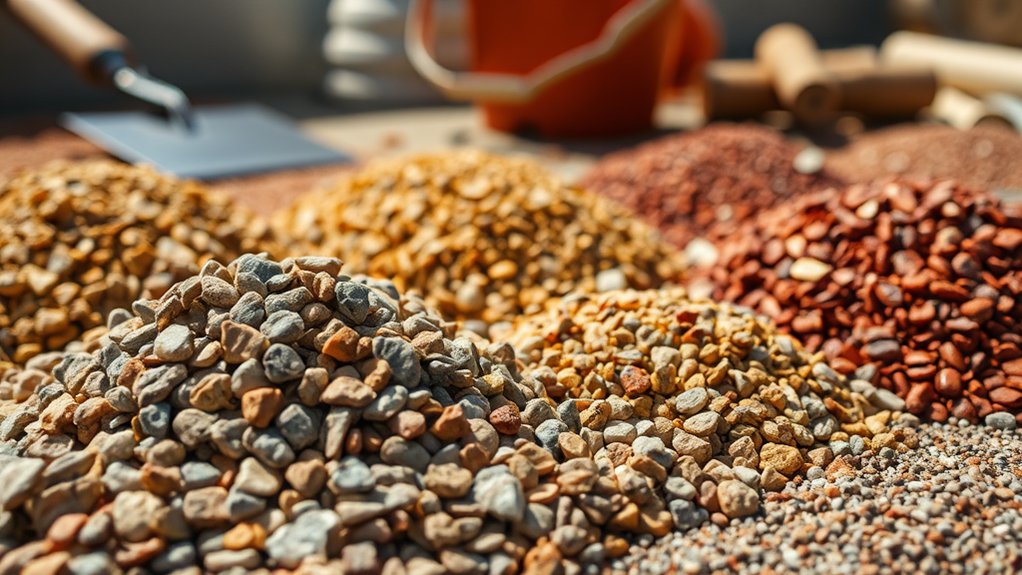
Installation Guide for Best Performance
Essential steps for a quality resin-bound gravel surface:
- Cleanliness: Ensure area is clean, dry and weed-free for proper bonding. A quick brush with a stiff broom will do the job.
- Base Strength: Your concrete or tarmac base must be sturdy enough for its intended use – whether it’s a garden path or car park.
- Temperature: Lay on a dry day when ground temperature exceeds 10°C. British weather being unpredictable, autumn and spring installations often work best.
These basics make the difference between a surface that lasts and one that fails.
Think of it like painting – the prep work matters as much as the finish.
Cost Analysis and Budgeting for Your Project

Cost Breakdown for Resin-bound Gravel Projects
Resin-bound gravel typically costs £85 to £130 per square metre, including installation. For a standard double driveway (roughly 50 square metres), budget between £4,250 and £6,500.
Site preparation costs vary based on your existing surface – removing old concrete or creating new foundations will add to the total.
Smart ways to manage costs:
- Get quotes from at least three contractors
- Choose mid-range aggregates that balance looks and durability
- Consider simpler designs for larger areas
- Factor in annual maintenance costs
Remember, prices increase for complex patterns, multiple colours or tricky installation spots like slopes.
Whilst quality materials cost more initially, they often prove more cost-effective long-term by reducing repairs and replacement needs.
The Importance of Aggregate Quality

The Quality of Aggregates in Resin-Bound Gravel
Proper aggregate selection directly affects how well a resin-bound surface performs and lasts. Top-quality aggregates bond effectively with resin, much like how good flour is essential for baking bread.
Three vital quality checks include:
Cleanliness
Aggregates must be spotless and free from dust – even small amounts of dirt can weaken the bond, rather like how a dirty surface stops paint from sticking properly.
Dryness
Like oil and water, resin and moisture don’t mix. Use only thoroughly dried aggregates to ensure proper bonding.
Batch Consistency
Source materials from the same batch to maintain an even colour and strength, similar to matching paint batches for consistent wall colour.
Getting these basics right saves time and money in the long run.
Quality aggregates might cost more initially but pay off through reduced maintenance and longer surface life.
Choosing the Right Texture for Your Surface

Choosing the proper texture for your resin-bound surface is crucial for both looks and practicality.
A smooth finish works brilliantly in areas like garden paths and patios where people walk, whilst rougher textures suit driveways where you need better grip for vehicles.
Think about how the texture matches your property – a sleek finish might complement a modern home, whereas a more textured surface could suit a rustic setting.
The texture you pick will also affect how easy it’s to keep clean and how well rainwater drains away.
Aggregate Surface Finish
Selecting the proper texture for aggregate surface finish matters for both looks and function. The right texture ensures proper resin bonding and delivers the desired finish.
Key points to consider:
- Grain Size: Finer aggregates yield smoother surfaces – think fine sand versus pebbles. Smaller grains typically offer better strength and a more polished appearance.
- Colour Consistency: Check that your aggregate batches match, particularly for larger projects. Mismatched colours can spoil the overall finish of paths or driveways.
- Material Strength: Always use kiln-dried aggregates. These resist British weather better and last longer than standard options.
Remember to test your chosen aggregate on a small area first. It’s far better to spot any issues early rather than halfway through the job.
Texture and Functionality
The right aggregate texture significantly impacts how resin-bound surfaces look and perform. Finer textures boost grip and safety, whilst mixing different sizes (typically 1-3mm and 2-5mm) creates a more stable surface that can handle heavy loads better.
Smaller stones fill gaps between larger ones, strengthening the overall structure and helping rainwater drain through effectively. The surface’s porosity makes it ideal for British weather, helping prevent puddles and flooding – a key feature for modern drainage requirements.
When choosing aggregate textures, it’s worth considering both practical needs and appearance. A busy driveway might need more grip than a garden path, for instance. Getting this balance right ensures your surface looks good and performs well year-round, whether it’s facing summer heat or winter rain.
Consulting Professionals for Best Results
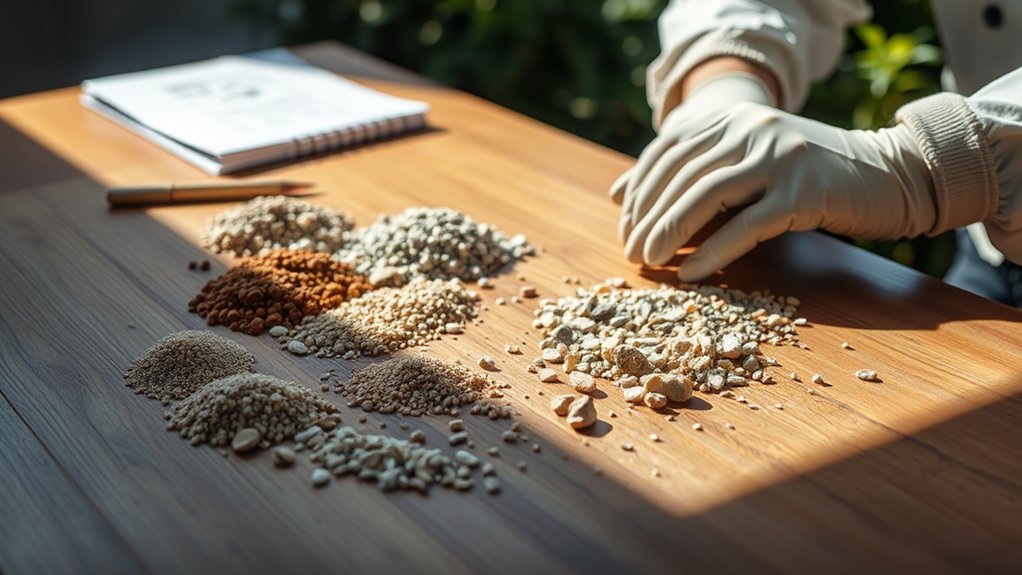
Consulting with professionals can greatly enhance your project’s outcome, as their expertise guarantees that you select the most suitable aggregate for resin-bound gravel.
Here are three key reasons to seek professional recommendations:
- Project Requirements: Professionals assess your specific project needs, ensuring the right aggregate sourcing based on site conditions and environmental factors.
- Aggregate Quality: Their insights help you choose aggregates that are clean, dry, and consistent, which are essential for durability and proper bonding.
- Aesthetic Goals: Professionals guide you in selecting aggregates that not only meet industry standards but also align with your desired visual appeal.
Frequently Asked Questions
How Do I Determine the Right Aggregate Size for My Project?
When choosing aggregate size, consider your project’s specific needs, including expected traffic load, desired look and required durability. Large aggregates (20-40mm) work best for foundations and heavy-duty surfaces like car parks, whilst smaller ones (10mm or less) suit pathways and decorative finishes. For standard domestic driveways, 10-20mm aggregate typically offers the ideal balance of strength and workability.
Can I Mix Different Aggregate Colors for a Unique Look?
You can absolutely mix different coloured aggregates to create distinctive surfaces. Combining shades like warm amber with grey, or deep charcoal with white, adds depth and character to driveways, paths or garden features. Just ensure you blend the colours thoroughly to avoid patchy areas. Popular mixes in the UK include Portland stone with black granite, or red granite with limestone – both offering elegant, lasting finishes that complement British architecture.
What Environmental Regulations Affect Aggregate Sourcing?
Strict environmental regulations govern aggregate sourcing in the UK. The rules cover quarry operations, water protection and dust control, whilst promoting the use of recycled materials. Key requirements include Environmental Impact Assessments for new sites, noise monitoring and restoration plans. Local councils and the Environment Agency actively enforce these measures to protect British landscapes and communities.
How Does Weather Impact Aggregate Selection and Installation?
Weather plays a vital role in aggregate selection and installation across the UK. Temperature swings and moisture levels directly affect how materials perform and bond. Choosing proper aggregates ensures lasting results – for instance, frost-resistant varieties for exposed driveways in Scotland, or quick-draining options for rainy regions. Poor selection often leads to cracking, loose stones and costly repairs, so it’s essential to get it right from the start.
Are There Specific Aggregates Better Suited for High-Traffic Areas?
Certain aggregates prove better suited for high-traffic areas, with granite and basalt standing out as top choices. These materials offer excellent durability and grip, particularly important for busy pavements and driveways. Their tough composition handles constant foot and vehicle traffic whilst maintaining a slip-resistant surface, even in wet British weather.
Conclusion
Selecting the right aggregate for your resin-bound gravel project is a crucial decision that affects both appearance and longevity. The aggregate choice determines the final look of your driveway, path or patio, whilst ensuring proper drainage and wear resistance. Consider factors such as stone size, colour and texture to match your property’s style. Local suppliers often stock suitable options, from traditional limestone to contemporary quartz blends, each offering different practical benefits. A well-chosen aggregate will serve you well through British weather conditions and regular foot traffic.
